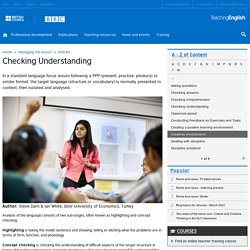

Home. Lizzie Pinard – Reflections of an English Language Teacher. Technologically and linguistically adventurous EFL teacher, trainer, writer and manager. Analysing Language. Checking understanding generally follows the isolation of new language which has been presented in context, analysed and fully explained.

It is this analysis and explanation stage which is the focus here. A framework for analysis Form and phonology Function and meaning Register and appropriacy Post analysis A framework for analysis The teacher may present language inductively through a text, a situation, through a task, or simply asks learners to 'notice' lexis. Alternatively a deductive approach may be used whereby the learners are given the rules and asked to apply them in using the language. In either case the learners need to fully understand the language before they begin to practise it in guided activities, or produce it together with other 'known' language. Form - the arrangement of the language, any rules which govern it, and any special difficulties which it presents.
You can use this form when preparing your lessons to ensure that you thoroughly analyse the language items. Checking Understanding. Analysis of the language consists of two sub-stages, often known as highlighting and concept checking.

Highlighting is taking the model sentence and showing, telling or eliciting what the problems are in terms of form, function, and phonology. Concept checking is checking the understanding of difficult aspects of the target structure in terms of function and meaning. Concept checking is vital, since learners must fully understand the structure before any intensive practice of form and phonology is carried out. Ways of checking understandingConcept questionsSome examplesLearning to construct concept questionsConclusion Ways of checking understanding Concept checking is normally achieved by the use of a set of questions designed to ensure comprehension of the target language, raise awareness of its problems, and to indicate to the teacher that the learners have fully understood.
The question 'Do you understand? ' Time lines to establish tenses. Target sentence: Look! Yes/no questions. Grouping students. Do you think about whether you’ve got a balance between pairs, groups, whole class and individual work? If you have activities for pairs and groups, do you let the students decide who they’re going to work with or do you decide? This tip looks at the advantages and disadvantages of the three main ways of grouping students. They are, giving students the choice, random grouping and selecting the groups yourself. You’ll probably find that no one way will always be the best choice for a particular group, but that you’ll use all three ways at different times depending on your students and the activities you plan to do.
Giving students the choiceThe chances are, if you let your students decide who they want to work with they will always stick to the same people. Paul Seligson, a well known TEFL author and teacher trainer, recently gave a workshop about classroom management at a conference here in Barcelona. By Jo BuddenFirst published 2008.
CELTA Lesson Frameworks. I had a request last week from a reader who wanted to know more about lesson frameworks.

I wrote about how useful they are a while back, but only gave one example. So, I’ve dug out my excellent CELTA handbook (from IH Budapest) and summarised most of the frameworks mentioned. I’ve added a bit of information to explain some stages a bit more. Here’s the basic structure for… Receptive skills lessons Note: receptive skills are reading and listening Lead-in – Generate interest in the topic / text. Checking answers. However, in the student-centred classroom this important stage in the learning process could be better exploited so as to be more engaging, interactive and empowering for our learners.

Why we check answers Checking answers to tests Make checking answers engaging Make checking answers interactive Make checking answers empowering Conclusion Why we check answers We spend time checking answers once students have finished a class or homework exercise because learners need to: Be reassured that what they think they have understood is right, before going on to learn and acquire it entirely Have repeated exposure to language to aid acquisition Be encouraged to think about why an answer is correct, or how they have reached a particular answer Have a record of correct language for future reference Have support at different levels. As teachers we need to: The lesson following the test, I asked students how they felt about it. Put the answers on the board, but not in the correct order. Marta J. Asking questions. Questioning is crucial to the way teachers manage the class, engage students with content, encourage participation and increase understanding.

Typically, teachers ask between 300-400 questions per day, however the quality and value of questions varies. While questioning can be an effective tool, there is both an art and science to asking questions. Every question demands a response (except in the case of requests and suggestions), so that questions inevitably generate communication. However the quantity of questions asked needs to be considered in relation to general time constraints and the need to keep teacher talking time to a minimum while maximising learner contributions. Types of questionsPurposes of questionsEffective questioningConclusion Types of questions There have been a number of typologies and taxonomies of questions. Display questions. What does ..... mean? Referential questions. What do you think about .....? Classroom Management & Resources – Google Drive.